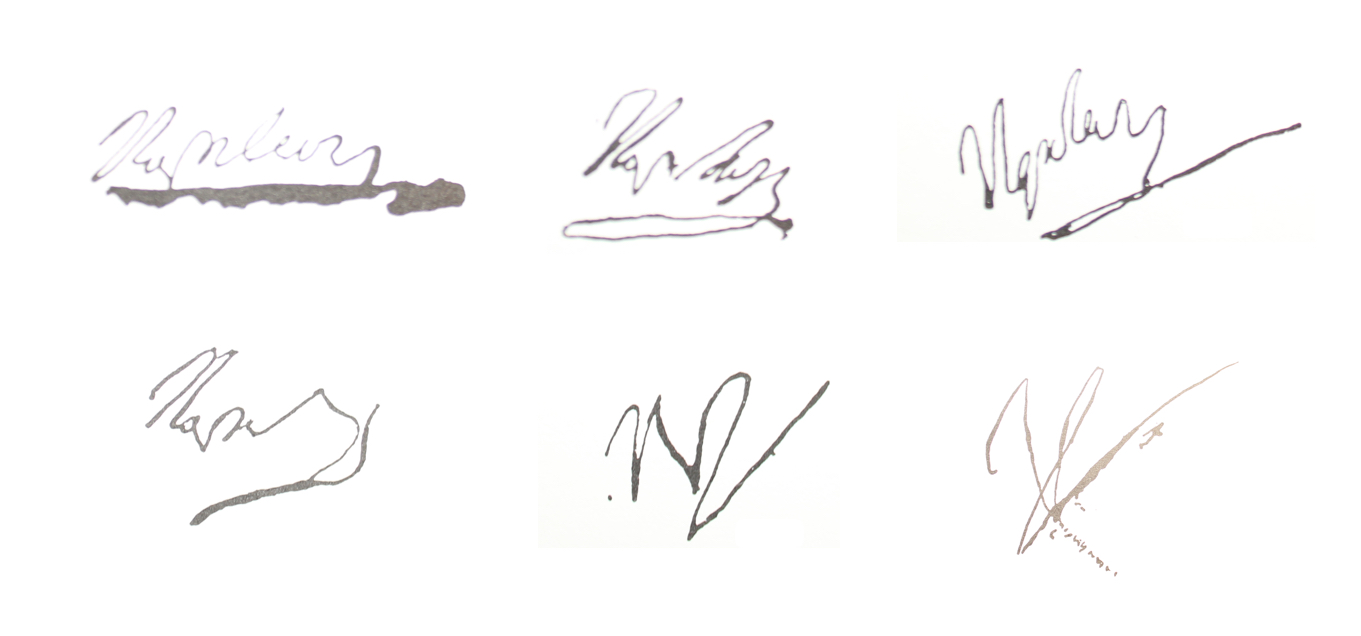You Can Change Your Handwriting (But Do You Want To?)

If you're unhappy with your current handwriting, you might want to know whether or not you can change it. I've done proper research and here's what I came up with.
Can you change your handwriting? You can definitely change your handwriting. People change their handwriting constantly during their lifetime. Graphologists agree that you can, but the underlying characteristics will remain.
But which of your two handwriting styles are you actually trying to improve? Yes, you have multiple. Read on to find out why.
You Can Change Your Handwriting
I’ve changed my hand pretty dramatically over the years. And according to graphologists, most people change their handwriting multiple times over the span of their lifetime. I've had a cool cursive kind of handwriting. I've also written in print for a period, and now I use some sort of strange hybrid form. Oh, not to forget, in elementary I obviously wrote in perfect cursive (ha-ha, not).
Truth is, people change their handwriting all the time. The real question is whether you want to, why you want to, and which one.
Graphology Agrees
I've been studying graphology lately. Graphology is the scientific study and analysis of handwriting. Graphologists (people who analyse handwriting) agree: you can definitely change your handwriting.
They also seem to agree that while you can change form, the underlying characteristics will remain. You can change your handwriting ...
“In an infinite variety of ways [ ... ] such changes are only apparent, and [ ... ] the basic features remain the same.”
- Graphology, The Art of Interpreting Handwriting, p. 9, Monique Le Guen
Graphology is a type of "physiological psychology." Your handwriting is an extension of your character, they say - that's why it's constantly evolving, just like your character. It changes with your mood, health, age, and even the outside temperature. That's right, graphologists can tell whether it was cold outside by looking at your handwriting.
So your handwriting can change and definitely will change over your lifetime. Can you design your own handwriting? Yes you can, but be aware that graphologists will be able to spot pretenders from a mile away. However, don't worry, because you can still get yourself a good, legible and professional handwriting, without being an imposter.
Napoleons Signature
When looking at historical signatures, people change them constantly. Let's take, for example, Napoleon's, it's easy to see that his signature changes constantly. Here's an example of his signature over the course of ten years:

This is interesting to me, since nowadays, we see our signature as something permanent, something that isn't to be changed. But graphologists will say: a signature can always be recognized, because we can recognize the underlying features of the writer.
This makes me wonder whether our idea of our handwriting has changed.
Why are you trying to change your handwriting?
Most people want to change their handwriting because they think their handwriting is bad. I used to think the same. Your handwriting needs to be legible, right? Of course, legible handwriting is better than illegible, right? Not necessarily- not all change is actually an improvement. To understand this, we need to dive a little deeper into the different hands people have.
Which handwriting are you trying to improve?
You actually have two handwriting styles: professional and personal. Historically, this makes sense. Whenever you needed to place an order at work, or send out a memo, you needed to write it by hand. There was a lot of that - handwriting. It needed to be legible, and fast as well. That's why most people naturally developed a professional hand - which is neater, faster, - more neutral.
What Handwriting Are You Trying To Improve?
Most people already changed their handwriting once in their lifetime. When you start your professional life, most people need to learn a legible, fast and neutral handwriting. Graphologist differentiate between professional and personal hand.
The Difference Between Personal and Professional Hand
This is where it becomes really interesting in my opinion. I've never thought of having two handwriting styles - I always thought I had one, and one alone, which I'd need to use in EVERY situation. Well, surprise: you don't. You can have an entirely different handwriting for family and friends, and the outside world.
I want to argue that you don't want to optimize your personal hand in any way - you want to keep it as natural as possible. Your professional hand, however, can be as clean and optimized as you want.
Let's have a look at the differences between the two, and what makes for good professional and personal hand.
Your Professional Hand
Professional hand is kind of like your personal pocket printer. You need a quick, easy to read, neat handwriting. You don't want your handwriting to give away your current mood, and also not too much of your character.
In a way, it's the neutral, simplified form of your personal hand, which is something else entirely.
You can improve your professional hand by using cursive or print work sheets, which are available online for free. You can also design your own handwriting by selecting elements from fonts you like.
Nowadays, you don't really need a professional hand as much, since everything business-related will most likely be typed and printed.
Your Personal Hand
When we look at personal hand, we look at the oppossite end of the spectrum. Your personal hand can be used for your family and friends, or your personal journal. This hand may require some effort on the part of the reader. Not everyone needs to be able to read this - heck, you can argue it's even better if almost nobody can. You write down your inner most secrets in this hand, which means only you and a select group of people can read it.
If you 'improve' your personal hand to the extent that it no longer shows your natural character, you have lost your personal hand. That's what I meant when I said not all change is improvement.
Da Vinci is a great example of personal and professional handwriting
A great example of a different personal and professional hand is Leonardo da Vinci's handwriting. It's well-known that he used to write in mirror image when taking notes. However, he also needed to write letters to strangers, patrons, and so on. There is, for example, a well-preserved letter of recommendation to Ludovico Sforza, ruler of Milan, in which Da Vinci tries to persuade him to hire him as his military engineer.
Calligraphy is a professional hand
This may come as a surprise, but calligraphy is a form of a professional hand. It's a uniform, stylized, and very easy to read hand, which was used during the Middle Ages by scribes for copying books. Fun fact: in Medieval times, almost no one had a personal hand.
How to improve your professional hand
You can improve your professional hand by printing out worksheets, which are available online for free. Decide on whether you want to use cursive or print sheets, and simply practice your writing on the sheets.
How to improve your personal hand
In my opinion, the only real ways to improve your personal hand, are:
- write a lot
- use the right tools
- improve your character
Graphology Can Recognize Your Handwriting No Matter What
If you decide to change your handwriting, graphologists will still be able to tell it was you who wrote it. There are even machines that are used to tell whether a piece of writing was written by the same, or a different person. It's remarkable how accurate this technology is. Of course, it's used to find forgeries nowadays.
As I've noted earlier, you can change your hand, but not the basic features of your handwriting. Graphologists note the difference between habitual writing and natural writing. So whenever you've taught yourself to do a specific curl, or motion, which doesn't really come naturally to you, they will be able to tell.
How To Change Your Handwriting
Now, that doesn't mean you shouldn't try to improve your handwriting. But everyone has motions that come naturally to us. Changing your handwriting is about recognizing what comes natural, and emphasizing these motions while getting rid of unnatural strokes. Sounds difficult? No worry, your body does this automatically. That's why kids' handwriting will differ, even just a couple of years after first learning to write.
In Conclusion
If you decide to change your handwriting, keep in mind that it's okay to have a personal hand, only known to you and your loved ones. Teach yourself a 'print-like' handwriting style to use for writing memos, grocery lists, and business letters. Use it to make a good impression. But also, don't forget your personal hand, which shows your real character and personality. That one may very well be messy.
Did you find the answer to your specific question?
👍 125 👎 15
Comments
Kate Gladstone
As a handwriting teacher who used to write illegibly (Until I achieved illegible handwriting at age 24), I am naturally interested in everything you’ve said in this article, and certainly I am interested to know that you, too, have improved your own handwriting over the years. Do you have any information, on your web insight and/or elsewhere, about how you improved your own handwriting? I ask because I could probably learn a great deal by seeing the various pathways that others took towards a better handwriting.
Leave a comment